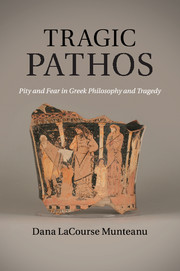Book contents
- Frontmatter
- Contents
- Preface and acknowledgments
- List of abbreviations
- Introduction
- Part i Theoretical views about pity and fear as aesthetic emotions
- Chapter 1 Drama and the emotions: an Indo-European connection?
- Chapter 2 Gorgias: a strange trio, the poetic emotions
- Chapter 3 Plato: from reality to tragedy and back
- Chapter 4 Aristotle: the first “theorist” of the aesthetic emotions
- Part ii Pity and fear within tragedies
- Appendix Catharsis and the emotions in the definition of tragedy in the Poetics
- Bibliography
- Index
- References
Chapter 4 - Aristotle: the first “theorist” of the aesthetic emotions
Published online by Cambridge University Press: 05 December 2011
- Frontmatter
- Contents
- Preface and acknowledgments
- List of abbreviations
- Introduction
- Part i Theoretical views about pity and fear as aesthetic emotions
- Chapter 1 Drama and the emotions: an Indo-European connection?
- Chapter 2 Gorgias: a strange trio, the poetic emotions
- Chapter 3 Plato: from reality to tragedy and back
- Chapter 4 Aristotle: the first “theorist” of the aesthetic emotions
- Part ii Pity and fear within tragedies
- Appendix Catharsis and the emotions in the definition of tragedy in the Poetics
- Bibliography
- Index
- References
Summary
Pity and fear as responses of the audience in the poetics: an impasse
After a pause, Stephen began: Aristotle has not defined pity and terror. I have. (J. Joyce, A Portrait of an Artist as a Young Man, New York, 1922 [first published, 1916] 239)
Stephen Dedalus works out a definition of pity and terror, deploring the fact that Aristotle had not provided one in the Poetics and ignoring the fact that he had done so in the Rhetoric. (Umberto Eco, “The Poetics and Us,” in Umberto Eco On Literature, transl. M. McLaughlin, Orlando: Harcourt, 2004, 238)
It is difficult to understand from the Poetics how pity and fear might affect the audience of tragedy, psychologically, morally, or otherwise. Although Aristotle repeatedly mentions the two emotions in the treatise, he does so without specifying their ethical influence on the spectator. This aspect of the Poetics continues to puzzle scholars, especially after Plato's condemnation of tragic pity as disabling the moral strength of the audience. Furthermore, the brief references to tragic emotions do not pertain to the audience straightforwardly, but rather emphasize the conditions under which plot and characters bring about fear and pity. Besides occurring in the controversial context of the definition (Po. 6.1449b27), pity and fear can be evoked by the events of the play: “[tragedy] is not only an imitation of complete action, but also of the fearful and pitiable” (οὐ μόνον τελείας ἐστὶ πράξεως ἡ μίμησις, ἀλλὰ καὶ φοβερῶν καὶ ἐλεεινῶν, Po. 9.1452a2–3). Later on, Aristotle describes what sort of characters can make the tragic action fearful and pitiable (e.g. Po. 13.1452b32, 36; 13.1453a1, 3–4) and insists that “playwrights ought to contrive the pleasure from pity and fear” (τὴν ἀπὸ ἐλέου καὶ φόβου διὰ μιμήσεως δεῖ ἡδονὴν παρασκευάζειν τὸν ποιητήν, Po. 14.1453b12–13). And this should be built into events, which are further discussed as “the sort of things that seem terrible and pitiable” (ποῖα οὖν δεινὰ ἢ ποῖα οἰκτρὰ φαίνεται, Po. 14.1453b14).
When Aristotle insists that the structural elements of a play convey the two tragic emotions, he implies that they should do so for the sake of the audience. On one level, pity and fear are embedded into the internal structure of tragedy, on another, they are felt by the spectator. And yet, the effect of the tragic emotions on the spectator remains unspecified. Aristotle offers almost no elucidation about the psychology of the audience experiencing the emotions, in the manner in which Gorgias and Plato did. Moreover, Aristotle does not seem interested in discussing the moral and political implications of feeling pity and fear in this treatise. When he does refer to psychology, he uses very general terms, in order to distinguish between the emotions appropriate for the viewer of tragedy and other possible emotional reactions. For example, a prescription (that tragedy should not depict a very wicked person falling from prosperity to adversity, because this may elicit a fellow-feeling, but not the appropriate tragic pity) is followed by an impersonal parenthesis: “pity is felt for the undeserving, fear for the one alike” (Po. 13.1453a4–6). Therefore, Aristotle appears to have a different theoretical focus than a discussion of the emotional psychology of the audience in the Poetics, namely an interest in the dramatic techniques that can elicit the correct aesthetic emotions, the right varieties of “pity and fear” that ought to be distinguished from other emotional responses.
- Type
- Chapter
- Information
- Tragic PathosPity and Fear in Greek Philosophy and Tragedy, pp. 70 - 138Publisher: Cambridge University PressPrint publication year: 2011



